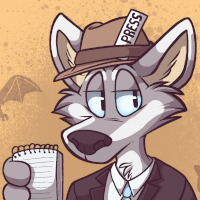Slave Trade, by comidacomida – book review by Fred Patten
by Patch O'Furr
Submitted by Fred Patten, Furry’s favorite historian and reviewer.
 Slave Trade,, by comidacomida. Illustrated by SpottyJaguar.
Slave Trade,, by comidacomida. Illustrated by SpottyJaguar.
Birmingham, AL, Two-Lips Press, January 2017, hardcover $29.99 (466 pages), Kindle $9.99.
The first sight of the telephone-sized hardcover edition of this book is stunning. It’s a huge 8½ x 11 x 1-inch tome that’s almost impossible to hold open without using both hands, and so heavy (over 3 pounds) that it’s tiresome to hold it without resting it on a table or your lap. Slave Trade seems designed mostly for Kindle sales, although each 8½ x 11” page takes two pages to fit onto a Kindle reader. Amazon says that the Kindle edition is 912 pages.
Slave Trade is a furry erotic adventure-fantasy (although there is no rating) set in a Medieval/Renaissance-like world that is not quite funny-animal. There are six main mammal kingdoms; three for anthro animals with plantigrade (flat) legs like bears, rodents, and primates – Tenvier, Larana, and Pross — and three for those with digitigrade (walking on toes) legs; canines, felines, ungulates — Diermyna, Meisenyl, and Vensii. Some practice slavery; others don’t. Usually the characters act so human that they might as well be funny animals; then someone does something that could only be done with an animal’s nature.
“The porcupine [Gaius, a tanner] reached back behind himself to snap a quill free; he then used it to pin up a loose section of leather on the harness.” (p. 84)
Most of this takes place on the vast estates of Lord Hector Desanti, a white Stag nobleman from Vensii now residing in Pross. The main character is Sidney, a young slave (Fox) on Lord Hector’s estates. Sidney hero-worships Lord Hector from afar; he’s like a god to Sidney. So he’s stunned when Lord Hector not only notices him, but gives him personal attention.


 Kismet, by Watts Martin
Kismet, by Watts Martin (Patch:) The Furry Writers’ Guild Coyotl Awards have just
(Patch:) The Furry Writers’ Guild Coyotl Awards have just  Memoirs of a Polar Bear, by Yoko Tawada. Translated by Susan Bernofsky.
Memoirs of a Polar Bear, by Yoko Tawada. Translated by Susan Bernofsky. Housepets! Don’t Ask Questions (Book 7), by Rick Griffin
Housepets! Don’t Ask Questions (Book 7), by Rick Griffin Sythyry’s Journal: A World Tree Chronicle of Transaffection, Adventure, and Doom, by Bard Bloom
Sythyry’s Journal: A World Tree Chronicle of Transaffection, Adventure, and Doom, by Bard Bloom Interlude: A Series of Shorts, by M. R. Anglin.
Interlude: A Series of Shorts, by M. R. Anglin. The Art and Evolution of TwoKinds, Volume 1, by Thomas Fischbach
The Art and Evolution of TwoKinds, Volume 1, by Thomas Fischbach A Glimpse of Anthropomorphic Literature, AnthroAquatic, ed.
A Glimpse of Anthropomorphic Literature, AnthroAquatic, ed.